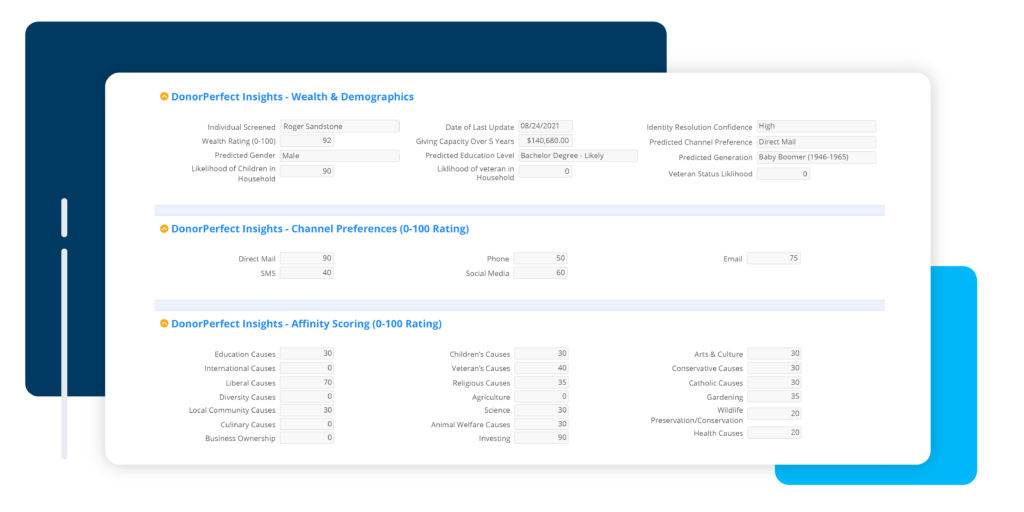Nonprofit CRMs are an excellent tool to manage donor data, and often, a CRM’s highly customizable nature makes it easy to collect and store all the information you could possibly need. This abundance of information IS an advantage, but it can also feel overwhelming when it comes to dredging through donor file after donor file to find what you need.
Just recently I was talking with a nonprofit client who asked what seemed like a simple question: “Why can’t I search in any field like Google?”
It was a great question, and it led me to some interesting discoveries.
Google and other search engines do a great job of indexing most of the Internet. But they do have a huge advantage – time is on their side. You may not realize it, but changes made to a website’s content can take days (or even weeks) for the pages to show up in the search engine results. The reason being it takes a VERY LONG time to index all words or phrases in anything (and this includes web pages, documents, and databases).
Nonprofit CRM softwares know its impractical for users to wait for a change to be included in their index. So a trade-off is made between how much data is indexed and the speed of entering and retrieving fundraising and donor data. Fortunately, with a little creativity and the power of your CRM you can still easily and efficiently find the donor data you need.

What kind of search do you need?
When it comes to a search in your CRM, you typically have two options: using the search tool or using a filter and report. Depending on what your needs are, both have advantages and disadvantages.
Search Tool: The search tool has the advantage of being much quicker. You do not have to do any preparation work. Simply type in a keyword or phrase into a search field.
(You may be limited to a set number of fields to search on, but some nonprofit CRMs, like DonorPerfect, offer search screen customizations.)
| Advantages | Disadvantages |
|
|
Filter and Report: Applying a filter to a report will take more time but has the advantage of being more comprehensive in terms of the records returned and the fields of data included. You also have the added advantage of being able to filter on any field in the database.
| Advantages | Disadvantages |
|
|
When it comes to determining what type of search option works best for you, try answering these questions:
- What am I doing with the results?
(Ex. Search screen would be better suited for editing a particular record where as a report would be better suited for creating a mailing list.) - Will I need these search results again in the future?
- Do I just need a handful of records or a large list?
- Can I search in my desired field on the search screen?
Which fields should I search within?
After you’ve determined the type of search you need to perform, it helps to get creative with the fields to search within. Once again, the purpose of your search will help to determine what fields will yield the best results. Let’s review some useful examples to get you started.
Purpose: I want to avoid creating duplicate records during data entry
Something as simple as searching for existing donor records to prevent duplication can present a challenge if data entry is inconsistent or inaccurate. Consider a donor named Robert who commonly goes by Bob. If you search for his record using his full first name and last name his record may not return in the results. In scenarios such as this, try using several search criteria:
- Search by Last Name only
- Search by Address (this is a good option for finding spouse/partner records too)
- Search by Email Address only
Purpose: I need to prepare for an upcoming mailing by finding records with incomplete donor profiles.
How do you find donor data that isn’t there? This is definitely a scenario where you will need to build a filter, and it’s really quite simple. When you’re building a filter to find records with missing data choose the field you want to focus on and use a filter function that looks for blank (or null) fields. This is a great practice to get in to regularly to maintain your database. Search for donors with missing or incomplete addresses/phone numbers/emails etc. Do your best to obtain the missing information and for those records that you cannot update, identify them as a do not mail record to save costs on mailings.
Purpose: I need to delete old donor information.
It’s hard to let go of donor data. Just like that box of old computer wires, what if it comes in handy one day? If it’s just a record or two, you can use the search screen, but for searches that involve the removal of data, it’s best to handle this with a lot of care. A filter and report are the ideal option because a report can allow you to export and save the data first before you delete it. As far as searching for records to delete, consider searching on fields like their most recent gift date, most recent volunteer date, or most recent interaction with your organization.
(CRMs, like DonorPerfect, make it easy to create your own fields that will track information like a donor’s most recent contact with your organization.)
Nonprofit CRMs are a great resource to meet your fundraising goals and by asking the right questions, you can easily search for and find the donor information you need.
Your nonprofit data is meant to help your organization make more informed decisions that will ultimately lead to more revenue for your mission, not make your job harder than it needs to be. The Clean Data Checklist, available for free download below, is a customizable guide for your nonprofit data procedures, complete with best practices and examples. Here’s to healthier data that leads to better results!









